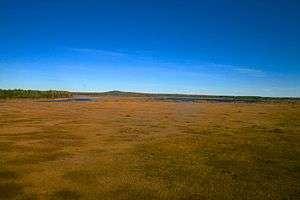South Småland peneplain

View of the South Småland peneplain at Store Mosse National Park. Note the residual hill or inselberg in the background.
The South Småland peneplain (Swedish: Sydsmåländska peneplanet) is a large flattish erosion surface, a peneplain, formed during the Tertiary, covering large swathes of southern Småland and nearby areas in Southern Sweden.[1][2] The South Småland peneplain is believed to never have been covered by sedimentary rocks.[2] To the south and west (chiefly Halland and Blekinge) the peneplain transitions into Mesozoic aged non-peneplain surfaces.[2] The surface extends over an altitude range of 100 to 150 meters above sea level. The existence of this plain was first noted by Sten De Geer in 1913 who termed it Smålands urbergslätt.[2]
See also
References
- ↑ Lidmar-Bergström, Karna. "Sydsmåländska peneplanet". Nationalencyklopedin (in Swedish). Cydonia Development. Retrieved June 22, 2015.
- 1 2 3 4 Lidmar-Bergström, Karna; Bonow, Johan M.; Japsen, Peter (2013). "Stratigraphic Landscape Analysis and geomorphological paradigms: Scandinavia as an example of Phanerozoic uplift and subsidence". Global and Planetary Change. 100: 153–171.
This article is issued from Wikipedia - version of the 10/31/2016. The text is available under the Creative Commons Attribution/Share Alike but additional terms may apply for the media files.